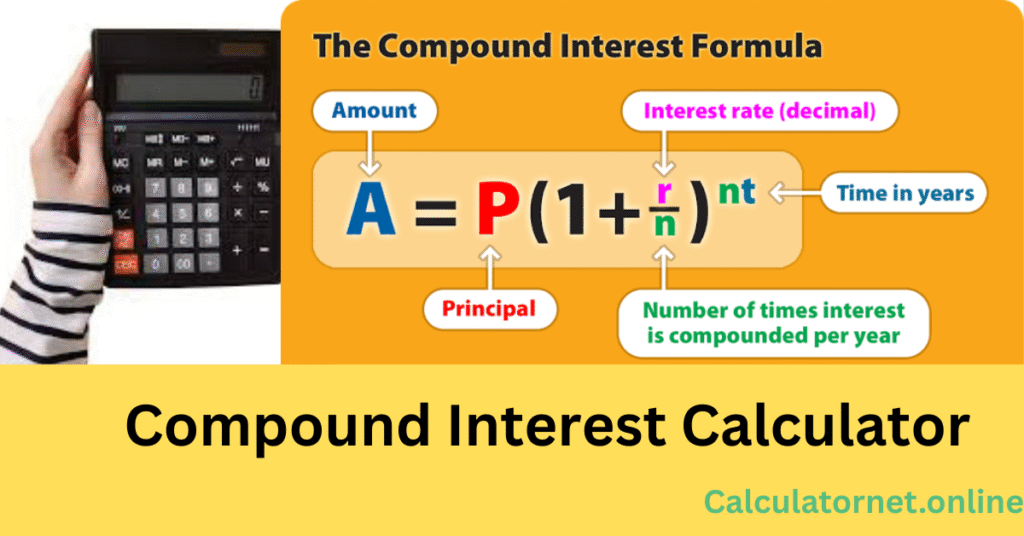Compound Interest Calculator
Contents
- 1 Compound Interest Calculator
- 2 Compound Interest: Your Guide to Growing Wealth
Compound Interest Calculator

Compound Interest Calculator
Watch your money grow with the power of compounding.
Compound Interest: Your Guide to Growing Wealth
Have you ever wondered how some people seem to build wealth effortlessly over time? The secret often lies in a powerful financial principle known as compound interest. This isn’t just a term for financial experts; it’s a fundamental concept that can transform your financial future. Whether you’re saving for retirement, a new home, or just starting to invest, understanding compound interest is the first step toward making your money work for you. This article will break down what compound interest is, how it differs from simple interest, and why it’s a “double-edged sword” that can either build your wealth or increase your debt. We’ll also explore the different ways it’s calculated and share some easy-to-understand formulas to help you master this essential financial tool.
What Exactly Is Compound Interest?
At its core, compound interest is the interest you earn on both your initial principal and the accumulated interest from previous periods. Think of it like a snowball rolling downhill: as it picks up more snow, it gets bigger and bigger, making it easier to pick up even more snow. The same principle applies to your money. Your initial investment earns interest, then that interest starts earning its own interest, creating a powerful, exponential growth cycle.
This is a key difference from simple interest, which is only calculated on the original principal amount. For example, if you invest $100 at a 10% simple interest rate for two years, you’ll earn $10 each year, for a total of $20. With a 10% compound interest rate, you’d earn $10 the first year, but in the second year, you’d earn interest on the new total of $110, earning $11. That’s an extra dollar, and over time, these small differences add up to massive gains.
The Double-Edged Sword of Compounding
While compound interest is a powerful tool for building wealth, it can also work against you. If you have high-interest debt, such as credit card balances or certain loans, the same principle of compounding can cause your debt to grow exponentially. Ignoring or only making minimum payments on outstanding debt allows the interest to compound, making it much harder to pay off in the long run. Just as compounding helps your savings grow, it can also cause your debt to spiral out of control.
How Compounding Frequencies Affect Your Money
The frequency with which interest is compounded—annually, monthly, daily, or even continuously—has a significant impact on your total returns. More frequent compounding periods lead to greater gains because your interest starts earning its own interest sooner.
- Annually: Interest is calculated and added to the principal once per year.
- Monthly: Interest is calculated and added twelve times a year, which is why mortgage loans and credit cards often use this frequency.
- Daily: This is the most common compounding frequency for savings accounts and Certificates of Deposit (CDs), leading to slightly higher returns than monthly compounding.
A higher compounding frequency can sometimes make an interest rate seem lower than it is. For example, a 6% mortgage rate compounded monthly is actually equivalent to a 6.17% annual percentage yield (APY) once you account for the compounding effect.
The Rule of 72: A Quick Financial Shortcut
Want a simple way to estimate how long it will take for your investment to double? The Rule of 72 is a popular shortcut for this exact purpose. Just divide the number 72 by your annual rate of return.
For example, if you have a fixed rate of return of 8%, it would take approximately nine years (72 / 8) for your investment to double. While this isn’t an exact calculation, it’s a fantastic, quick way to estimate the power of compound interest without a calculator.
The History Behind the Concept
The concept of compound interest isn’t new; it dates back to ancient civilizations like the Babylonians and Sumerians over 4,000 years ago. However, it was viewed with suspicion by many societies. Roman law, and even early Christian and Islamic texts, condemned it as usury. It wasn’t until the 1600s, with the creation of compound interest tables, that it began to gain wider acceptance.
The mathematical constant e, discovered by Jacob Bernoulli while studying compound interest, helped revolutionize the understanding of this financial principle. Bernoulli realized that as compounding frequency increased, the growth rate would approach a specific mathematical limit, which was later named e by Leonhard Euler. This constant, approximately 2.71828, is a cornerstone of modern financial mathematics.
Frequently Asked Questions About Compound Interest
How is compound interest different from simple interest?
Simple interest is only earned on the original principal amount. Compound interest, on the other hand, is earned on both the principal and the accumulated interest. This “interest on interest” effect is why compounding can lead to significantly faster wealth growth over time.
Can compound interest work against me?
Yes, it can. While it’s great for investments and savings, compound interest can work against you with high-interest debt like credit cards. If you only make minimum payments, the interest you owe will compound, causing your debt to grow exponentially and making it much harder to pay off.
What is the Rule of 72?
The Rule of 72 is a quick and easy way to estimate how long it will take for an investment to double. You simply divide 72 by the annual interest rate. For example, an investment with a 6% return will double in approximately 12 years (72 ÷ 6).
Is it better to compound monthly or annually?
Generally, the more frequently interest compounds, the better. Monthly compounding will lead to slightly higher returns than annual compounding because your interest starts earning interest sooner. This is especially true for long-term investments.
What is continuous compound interest?
Continuous compounding is the theoretical limit of compounding, where interest is calculated and added infinitely often. While it’s not practical in the real world, it’s a mathematical concept that shows how the gains from compounding eventually plateau, even with increased frequency.
How does compound interest help with retirement savings?
Compound interest is the main engine behind long-term retirement savings. By starting early, your contributions have more time to grow and compound, allowing even small, consistent investments to become substantial nest eggs over several decades.
Conclusion
Understanding compound interest is a game-changer for anyone looking to build financial stability. It’s the engine that can turn small, consistent savings into significant wealth over time. By harnessing its power through strategic investments and a commitment to paying down high-interest debt, you can put this powerful force to work for you. Remember, the earlier you start, the more time you give your money to compound and grow.
Ready to start making your money work harder? Share your favorite compound interest success story or financial tip in the comments below!







